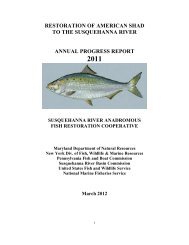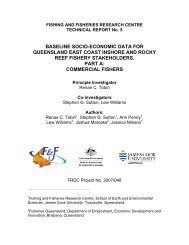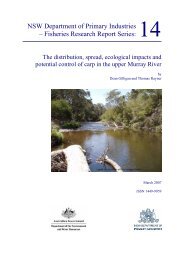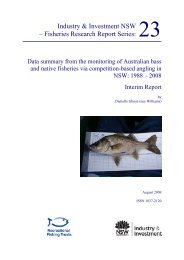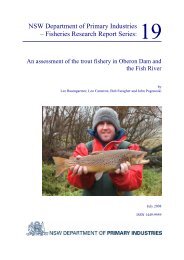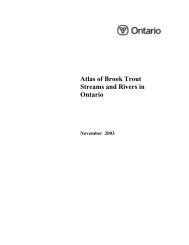Assessment of shark sighting rates by aerial ... - Fisheries Reports
Assessment of shark sighting rates by aerial ... - Fisheries Reports
Assessment of shark sighting rates by aerial ... - Fisheries Reports
You also want an ePaper? Increase the reach of your titles
YUMPU automatically turns print PDFs into web optimized ePapers that Google loves.
NSW DPI 17<br />
Percentage <strong>of</strong> analogues sighted + SE<br />
60<br />
50<br />
40<br />
30<br />
20<br />
10<br />
0<br />
0 m<br />
50 m<br />
100 m<br />
150 m<br />
200 m<br />
250 m<br />
300 m<br />
350 m<br />
Minimum distance from aircraft<br />
Figure 6. Percentage <strong>of</strong> validated analogue <strong>sighting</strong>s per aircraft with relative contribution <strong>of</strong><br />
different trial treatments. Open bars indicate fixed-wing data, closed bars indicate<br />
helicopter <strong>sighting</strong>s. Hashed bars indicates contribution <strong>of</strong> trials undertaken using<br />
standard methodology (cruising speed, no orbiting), non-hashed bars indicates<br />
contribution <strong>of</strong> alternative trials (orbiting permitted (fixed-wing), 100 kts airspeed<br />
(helicopter)). Contribution <strong>of</strong> each treatment type has been scaled to account for<br />
differences in sample size.<br />
Minimal differences were seen in fixed-wing <strong>sighting</strong> <strong>rates</strong> for trials where the pilots were<br />
permitted to orbit to verify <strong>sighting</strong>s, compared with non-orbiting flights (Fig. 6). In fact, more<br />
<strong>sighting</strong>s occurred on flights where circling was not permitted. Although the predisposition <strong>of</strong> the<br />
observers to expect large <strong>shark</strong>-like objects in the deployment grid may have contributed to their<br />
rapid identification, the <strong>sighting</strong> cue to perform the verification check (i.e. the decision that a<br />
submerged object is likely to be a <strong>shark</strong>) was sufficient in itself to successfully identify deployed<br />
analogues. This suggests there was no ambiguity in the identification <strong>of</strong> <strong>shark</strong> analogues during<br />
these experiments, nor any disadvantage to the fixed-wing aircrew when not permitting them to<br />
orbit suspected <strong>sighting</strong>s as per the normal routine on <strong>aerial</strong> beach patrols.<br />
Airspeed made minimal difference to the <strong>sighting</strong> ability <strong>of</strong> helicopter observers when flying<br />
within 250 m <strong>of</strong> deployed analogues (Fig. 6). However, trials conducted at the faster airspeed (100<br />
kts) failed to produce detected analogues at distances over 300 m from the helicopter flight path.<br />
Sighting <strong>rates</strong> over 300 m were however, comparable between helicopter observers flying at 60 kts<br />
and the fixed-wing observers at 100 kts once sample size was accounted for (Fig. 6). This indicates<br />
that the helicopter observers had equivalent, albeit low, capacity to detect distant analogues when<br />
their aircraft was travelling at cruising speed.<br />
<strong>Assessment</strong> <strong>of</strong> <strong>shark</strong> <strong>sighting</strong> <strong>rates</strong> <strong>by</strong> <strong>aerial</strong> beach patrols Robbins et al.<br />
400 m<br />
450 m<br />
500+ m




